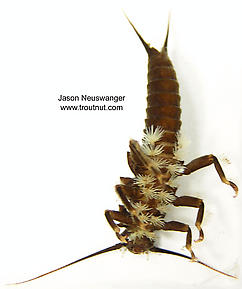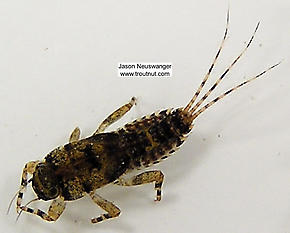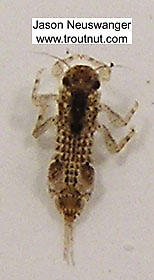Blog & Latest Updates
Fly Fishing Articles
Insects by Common Name


Updates from March 10, 2004
Closeup insects by Troutnut from Miscellaneous Wisconsin in Wisconsin
Ranatra Water Scorpion Adult View 7 PicturesHere's a big water scorpion (no relation to actual scorpions). These guys are just about the most sinister-looking creatures you could find, and what's especially creepy is that they can come up out of the water and fly around, as I learned when one left my aquarium and buzzed my head while I was peeking into the microscope at a mayfly nymph.
View 7 PicturesHere's a big water scorpion (no relation to actual scorpions). These guys are just about the most sinister-looking creatures you could find, and what's especially creepy is that they can come up out of the water and fly around, as I learned when one left my aquarium and buzzed my head while I was peeking into the microscope at a mayfly nymph.
 View 7 PicturesHere's a big water scorpion (no relation to actual scorpions). These guys are just about the most sinister-looking creatures you could find, and what's especially creepy is that they can come up out of the water and fly around, as I learned when one left my aquarium and buzzed my head while I was peeking into the microscope at a mayfly nymph.
View 7 PicturesHere's a big water scorpion (no relation to actual scorpions). These guys are just about the most sinister-looking creatures you could find, and what's especially creepy is that they can come up out of the water and fly around, as I learned when one left my aquarium and buzzed my head while I was peeking into the microscope at a mayfly nymph.Collected March 10, 2004 from unknown in Wisconsin
Added to Troutnut.com by Troutnut on January 25, 2006
Added to Troutnut.com by Troutnut on January 25, 2006
Pteronarcys dorsata (Giant Black Stonefly) Stonefly Nymph View 3 PicturesPteronarcys nymphs live for two years before maturing. This small one is in its first year.
View 3 PicturesPteronarcys nymphs live for two years before maturing. This small one is in its first year.
 View 3 PicturesPteronarcys nymphs live for two years before maturing. This small one is in its first year.
View 3 PicturesPteronarcys nymphs live for two years before maturing. This small one is in its first year.Collected March 10, 2004 from unknown in Wisconsin
Added to Troutnut.com by Troutnut on January 19, 2006
Added to Troutnut.com by Troutnut on January 19, 2006
Ephemerella subvaria (Hendrickson) Mayfly Nymph View 3 Pictures
View 3 Pictures
 View 3 Pictures
View 3 PicturesCollected March 10, 2004 from unknown in Wisconsin
Added to Troutnut.com by Troutnut on January 25, 2006
Added to Troutnut.com by Troutnut on January 25, 2006
Strophopteryx fasciata (Mottled Willowfly) Stonefly Nymph View 2 Pictures
View 2 Pictures
 View 2 Pictures
View 2 PicturesCollected March 10, 2004 from unknown in Wisconsin
Added to Troutnut.com by Troutnut on January 19, 2006
Added to Troutnut.com by Troutnut on January 19, 2006
Phryganeidae Caddisfly Larva View 3 Pictures
View 3 Pictures
 View 3 Pictures
View 3 PicturesCollected March 10, 2004 from unknown in Wisconsin
Added to Troutnut.com by Troutnut on January 19, 2006
Added to Troutnut.com by Troutnut on January 19, 2006
Siphloplecton basale (Pseudo-Gray Drake) Mayfly Nymph View 3 Pictures
View 3 Pictures
 View 3 Pictures
View 3 PicturesCollected March 10, 2004 from unknown in Wisconsin
Added to Troutnut.com by Troutnut on January 19, 2006
Added to Troutnut.com by Troutnut on January 19, 2006
Ephemerella (Hendricksons, Sulphurs, PMDs) Mayfly Nymph View 3 PicturesI confirmed with the microscope that this specimen has very small tubercles (
View 3 PicturesI confirmed with the microscope that this specimen has very small tubercles ( Tubercle: Various peculiar little bumps or projections on an insect. Their character is important for the identification of many kinds of insects, such as the nymphs of Ephemerellidae mayflies.), strongly double-banded tibiae (
Tubercle: Various peculiar little bumps or projections on an insect. Their character is important for the identification of many kinds of insects, such as the nymphs of Ephemerellidae mayflies.), strongly double-banded tibiae ( Tibia: A middle segments in the leg of an insect, located between the femur and the tarsus.), and a fan tail.
Tibia: A middle segments in the leg of an insect, located between the femur and the tarsus.), and a fan tail.
 View 3 PicturesI confirmed with the microscope that this specimen has very small tubercles (
View 3 PicturesI confirmed with the microscope that this specimen has very small tubercles (
A few (not all) of the abdominal tubercles on this Ephemerella needhami nymph are circled. They are especially large in this species.

The tibia of this Isonychia bicolor mayfly spinner is highlighted in red.
Collected March 10, 2004 from unknown in Wisconsin
Added to Troutnut.com by Troutnut on January 19, 2006
Added to Troutnut.com by Troutnut on January 19, 2006
Ephemerella invaria (Sulphur Dun) Mayfly Nymph View 3 Pictures
View 3 Pictures
 View 3 Pictures
View 3 PicturesCollected March 10, 2004 from unknown in Wisconsin
Added to Troutnut.com by Troutnut on January 19, 2006
Added to Troutnut.com by Troutnut on January 19, 2006
Ephemerella (Hendricksons, Sulphurs, PMDs) Mayfly Nymph View 2 PicturesHere's a puzzling nymph. It seemed to have double-banded tibiae (
View 2 PicturesHere's a puzzling nymph. It seemed to have double-banded tibiae ( Tibia: A middle segments in the leg of an insect, located between the femur and the tarsus.), although the second band wasn't very pronounced. It has quite prominent tubercles (
Tibia: A middle segments in the leg of an insect, located between the femur and the tarsus.), although the second band wasn't very pronounced. It has quite prominent tubercles ( Tubercle: Various peculiar little bumps or projections on an insect. Their character is important for the identification of many kinds of insects, such as the nymphs of Ephemerellidae mayflies.) that definitely aren't black.
Tubercle: Various peculiar little bumps or projections on an insect. Their character is important for the identification of many kinds of insects, such as the nymphs of Ephemerellidae mayflies.) that definitely aren't black.
 View 2 PicturesHere's a puzzling nymph. It seemed to have double-banded tibiae (
View 2 PicturesHere's a puzzling nymph. It seemed to have double-banded tibiae (
The tibia of this Isonychia bicolor mayfly spinner is highlighted in red.

A few (not all) of the abdominal tubercles on this Ephemerella needhami nymph are circled. They are especially large in this species.
Collected March 10, 2004 from unknown in Wisconsin
Added to Troutnut.com by Troutnut on January 19, 2006
Added to Troutnut.com by Troutnut on January 19, 2006
Ephemerella invaria (Sulphur Dun) Mayfly Nymph View 2 Pictures
View 2 Pictures
 View 2 Pictures
View 2 PicturesCollected March 10, 2004 from unknown in Wisconsin
Added to Troutnut.com by Troutnut on January 19, 2006
Added to Troutnut.com by Troutnut on January 19, 2006
Maccaffertium modestum (Cream Cahill) Mayfly Nymph View 3 Pictures
View 3 Pictures
 View 3 Pictures
View 3 PicturesCollected March 10, 2004 from unknown in Wisconsin
Added to Troutnut.com by Troutnut on January 19, 2006
Added to Troutnut.com by Troutnut on January 19, 2006
Ephemerella invaria (Sulphur Dun) Mayfly Nymph View 3 PicturesI confirmed with the microscope that this nymph has small tubercles (
View 3 PicturesI confirmed with the microscope that this nymph has small tubercles ( Tubercle: Various peculiar little bumps or projections on an insect. Their character is important for the identification of many kinds of insects, such as the nymphs of Ephemerellidae mayflies.), single-banded tibiae (
Tubercle: Various peculiar little bumps or projections on an insect. Their character is important for the identification of many kinds of insects, such as the nymphs of Ephemerellidae mayflies.), single-banded tibiae ( Tibia: A middle segments in the leg of an insect, located between the femur and the tarsus.), and a fan tail.
Tibia: A middle segments in the leg of an insect, located between the femur and the tarsus.), and a fan tail.
 View 3 PicturesI confirmed with the microscope that this nymph has small tubercles (
View 3 PicturesI confirmed with the microscope that this nymph has small tubercles (
A few (not all) of the abdominal tubercles on this Ephemerella needhami nymph are circled. They are especially large in this species.

The tibia of this Isonychia bicolor mayfly spinner is highlighted in red.
Collected March 10, 2004 from unknown in Wisconsin
Added to Troutnut.com by Troutnut on January 25, 2006
Added to Troutnut.com by Troutnut on January 25, 2006
Eurylophella (Chocolate Duns) Mayfly Nymph View 2 PicturesIt has the segment 4 gill and abdominal segment 9 is longer than segment 8. I couldn't see abdominal tubercles (
View 2 PicturesIt has the segment 4 gill and abdominal segment 9 is longer than segment 8. I couldn't see abdominal tubercles ( Tubercle: Various peculiar little bumps or projections on an insect. Their character is important for the identification of many kinds of insects, such as the nymphs of Ephemerellidae mayflies.), but they may not yet be developed in such an early instar (Instar: Many invertebrates molt through dozens of progressively larger and better-developed stages as they grow. Each of these stages is known as an instar. Hard-bodied nymphs typically molt through more instars than soft-bodied larvae.).
Tubercle: Various peculiar little bumps or projections on an insect. Their character is important for the identification of many kinds of insects, such as the nymphs of Ephemerellidae mayflies.), but they may not yet be developed in such an early instar (Instar: Many invertebrates molt through dozens of progressively larger and better-developed stages as they grow. Each of these stages is known as an instar. Hard-bodied nymphs typically molt through more instars than soft-bodied larvae.).
 View 2 PicturesIt has the segment 4 gill and abdominal segment 9 is longer than segment 8. I couldn't see abdominal tubercles (
View 2 PicturesIt has the segment 4 gill and abdominal segment 9 is longer than segment 8. I couldn't see abdominal tubercles (
A few (not all) of the abdominal tubercles on this Ephemerella needhami nymph are circled. They are especially large in this species.
Collected March 10, 2004 from unknown in Wisconsin
Added to Troutnut.com by Troutnut on January 19, 2006
Added to Troutnut.com by Troutnut on January 19, 2006
Ephemerellidae (Hendricksons, Sulphurs, PMDs, BWOs) Mayfly Nymph View 3 PicturesThis is a really really really really tiny mayfly nymph. It has gills on abdominal segments 3-7 in the characteristic orientation for the Ephemerellidae family, and it has no fain tail as best I can tell, just uniform tail coverage with small black hairs of equal length. I think this one's too young to identify.
View 3 PicturesThis is a really really really really tiny mayfly nymph. It has gills on abdominal segments 3-7 in the characteristic orientation for the Ephemerellidae family, and it has no fain tail as best I can tell, just uniform tail coverage with small black hairs of equal length. I think this one's too young to identify.
 View 3 PicturesThis is a really really really really tiny mayfly nymph. It has gills on abdominal segments 3-7 in the characteristic orientation for the Ephemerellidae family, and it has no fain tail as best I can tell, just uniform tail coverage with small black hairs of equal length. I think this one's too young to identify.
View 3 PicturesThis is a really really really really tiny mayfly nymph. It has gills on abdominal segments 3-7 in the characteristic orientation for the Ephemerellidae family, and it has no fain tail as best I can tell, just uniform tail coverage with small black hairs of equal length. I think this one's too young to identify.Collected March 10, 2004 from unknown in Wisconsin
Added to Troutnut.com by Troutnut on January 19, 2006
Added to Troutnut.com by Troutnut on January 19, 2006
Maccaffertium modestum (Cream Cahill) Mayfly Nymph View 2 PicturesI looked at this nymph closely under my crappy microscope. It has truncate (Truncate: Cut off. This is often used to describe the square appearance of the gills of Maccaffertium mayfly nymphs, for example, as opposed to the pointed gills of the closely related genus Stenacron.) as opposed to rounded gills, postero-lateral (Lateral: To the side.) spines only on abdominal segments 7-9, and oblique crossbars through the center of each sterna, not on the posterior (Posterior: Toward the back of an organism's body. The phrase "posterior to" means "in back of.") edge like on some of the other Maccaffertium species. As best I can tell from the keys this is either modestum or ithaca and from the distribution maps I've seen I'm guessing it's modestum.
View 2 PicturesI looked at this nymph closely under my crappy microscope. It has truncate (Truncate: Cut off. This is often used to describe the square appearance of the gills of Maccaffertium mayfly nymphs, for example, as opposed to the pointed gills of the closely related genus Stenacron.) as opposed to rounded gills, postero-lateral (Lateral: To the side.) spines only on abdominal segments 7-9, and oblique crossbars through the center of each sterna, not on the posterior (Posterior: Toward the back of an organism's body. The phrase "posterior to" means "in back of.") edge like on some of the other Maccaffertium species. As best I can tell from the keys this is either modestum or ithaca and from the distribution maps I've seen I'm guessing it's modestum.
 View 2 PicturesI looked at this nymph closely under my crappy microscope. It has truncate (Truncate: Cut off. This is often used to describe the square appearance of the gills of Maccaffertium mayfly nymphs, for example, as opposed to the pointed gills of the closely related genus Stenacron.) as opposed to rounded gills, postero-lateral (Lateral: To the side.) spines only on abdominal segments 7-9, and oblique crossbars through the center of each sterna, not on the posterior (Posterior: Toward the back of an organism's body. The phrase "posterior to" means "in back of.") edge like on some of the other Maccaffertium species. As best I can tell from the keys this is either modestum or ithaca and from the distribution maps I've seen I'm guessing it's modestum.
View 2 PicturesI looked at this nymph closely under my crappy microscope. It has truncate (Truncate: Cut off. This is often used to describe the square appearance of the gills of Maccaffertium mayfly nymphs, for example, as opposed to the pointed gills of the closely related genus Stenacron.) as opposed to rounded gills, postero-lateral (Lateral: To the side.) spines only on abdominal segments 7-9, and oblique crossbars through the center of each sterna, not on the posterior (Posterior: Toward the back of an organism's body. The phrase "posterior to" means "in back of.") edge like on some of the other Maccaffertium species. As best I can tell from the keys this is either modestum or ithaca and from the distribution maps I've seen I'm guessing it's modestum.Collected March 10, 2004 from unknown in Wisconsin
Added to Troutnut.com by Troutnut on January 19, 2006
Added to Troutnut.com by Troutnut on January 19, 2006
Most recent comments on this post (latest on top)
Comment on this post
Top 10 Fly Hatches
Top Gift Shop Designs
Eat mayflies.
Top Insect Specimens
Miscellaneous Sites
Troutnut.com is copyright © 2004-2024 Jason
Neuswanger (email Jason). See my FAQ for information about use of my images.
 privacy policy
privacy policy
